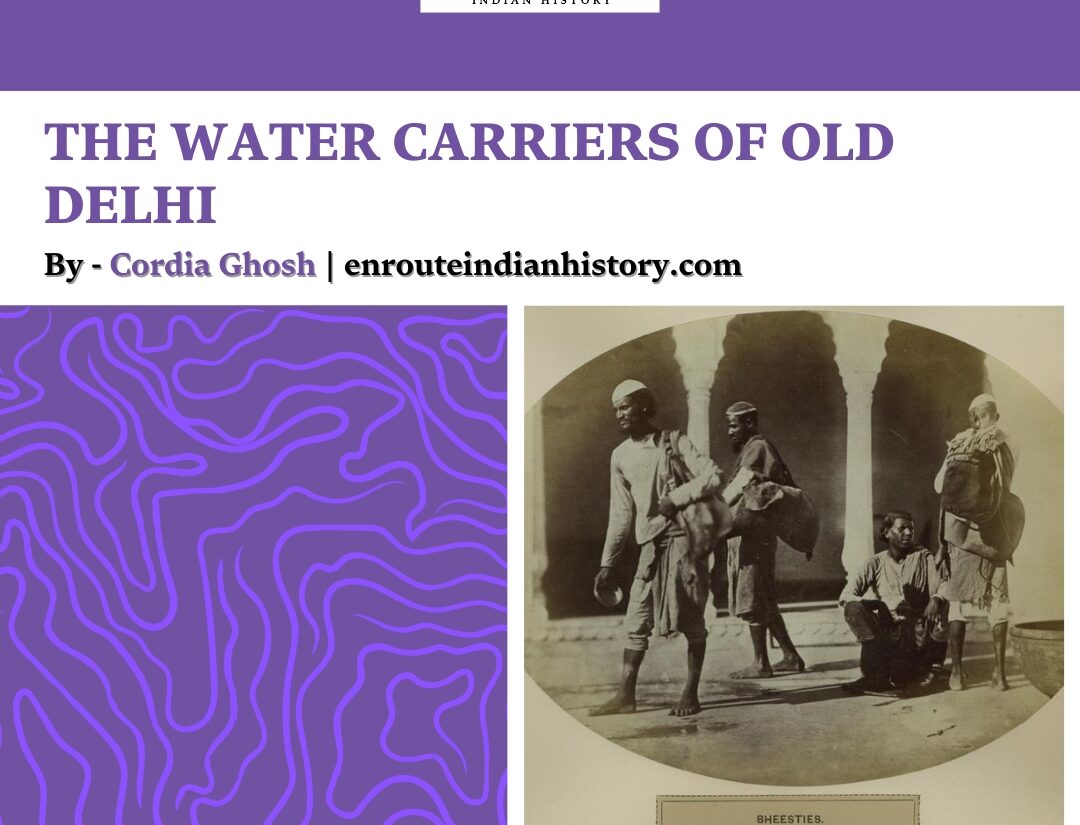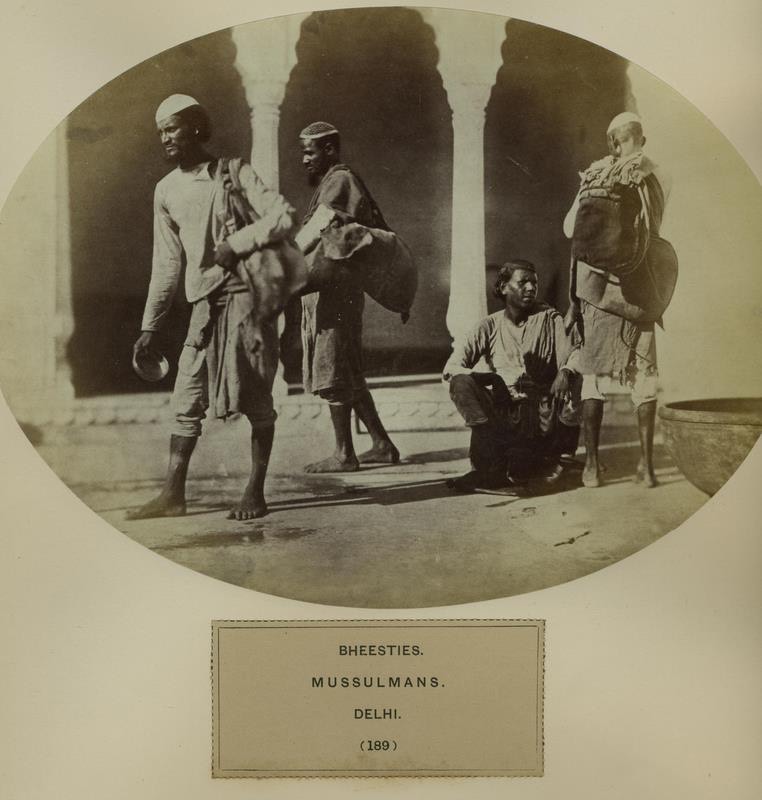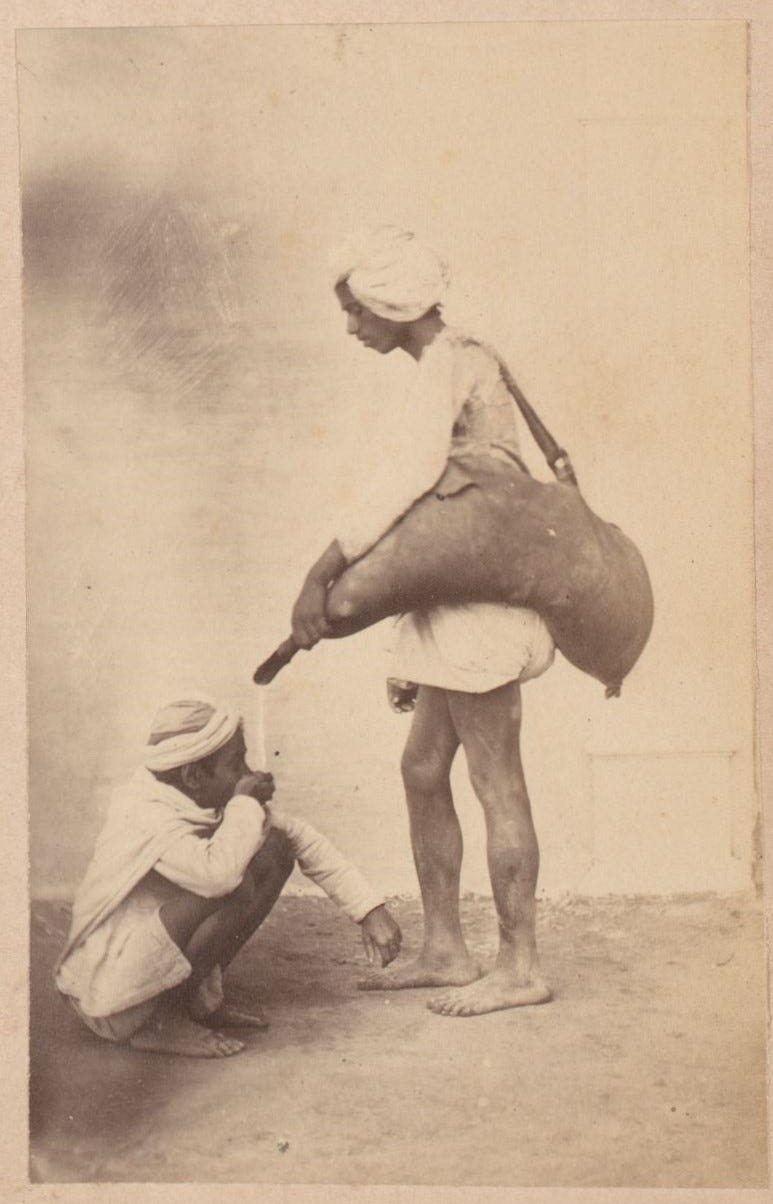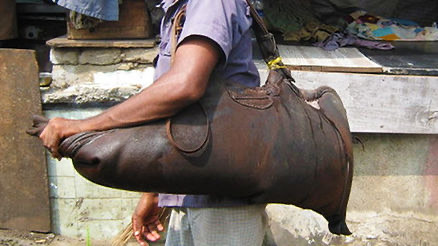

From ‘The People of India’ (1868 to the early 1870’s), by W. H. Allen, for the India Office
Water, the elixir of life, has a fascinating duality: in scarcity, it unites like the Yamuna, while in excess, it divides like the Ravi. It blurs boundaries and builds communities, and the profession of the Bhisti once exemplified this dynamic. Surprisingly, Dalit Muslims—once deemed untouchables—were the very people who provided drinking water to Hindus and Muslims of all castes from their leather satchels. Bhistis offers a glimpse into a bygone era when water was not just a utility but an intimate, local, and sacred element of urban life. Unlike today’s pipelines that channels water from far-off sources, water once made its way into homes, with the supply adapting to demand rather than the other way around. In today’s thirsty cities, where water is often distant and impersonal, we no longer know our water.
Old Delhi, with its kaleidoscopic alleys and vibrant street life, has long been a canvas of human drama and daily hustle. Among the myriad figures of merchants, pheri-walas, vendors, townsfolk, and weary travelers—who populated this bustling city, one stood out as a mirage of relief and sustenance: the Bhistiwallahs, the Traditional water carriers in Old Delhi. Clad in simple attire with a goatskin water bag, or “Mashak”, slung over his shoulder, the Bhisti was nothing short of a blessing—a mobile oasis amid the relentless heat, embodying the spirit of service and community resilience in 19th-century Delhi.
The term Bhisti is derived from the Persian word Behisht, meaning Paradise. In Persian, a Bhisti is an inhabitant of Paradise—essentially a cherub, seraph, or angel of mercy. Though he lacks wings, Bhisti’s heavy burden is symbolically akin to a celestial weight: a large goatskin, swollen to its limits with the life-giving elixir of life:- water. In historical Delhi, the bhisti’s role was functional and crucial to urban life. Tracing back to the Mughal era, when Delhi was a bustling imperial city, Bhisti emerged as a key figure. The city’s diverse population and vibrant trade often faced water scarcity, making the Bhisti’s presence essential to daily life.

A bhisti providing water to a child through his water bag | Rijksmuseum
Bhisti’s Enduring Symbolism in the Subcontinent’s History
You might wonder how the traditional occupation began. It traces back to 680 AD, rooted in the legacy of Hazrat Abbas, first recorded Bhisti in history, the son of the fourth Rashidun Caliph, Imam Ali. Known for his bravery and devotion, Hazrat Abbas earned the title ‘Saqqa,’ meaning water carrier, during the battle of Karbala in Iraq. In a heroic act, he sacrificed his life crossing the Euphrates River to bring water to his half-brother Imam Hussain’s children, forever linking his name to this noble profession.
In 1539, during the Battle of Chausa in present-day Bihar, a Bhisti became an unlikely hero by saving Mughal Emperor Humayun’s life. As the Emperor faced defeat against Sher Shah Suri, this nameless Bhisti ingeniously inflated his mashak, allowing Humayun to float across the Ganga to safety. In gratitude, the Emperor rewarded him with a day on the throne—a rare and remarkable commendation.
The Bhistis‘ legacy of bravery continued during the Uprising of 1857, where they provided crucial support to Indian sepoys and Begum Hazrat Mahal.
Rooted in the historical battlegrounds of Karbala, the bhistis continued to play a crucial role in the Subcontinent’s military history, serving with notable distinction throughout both the Mughal and British periods.
Role of Bhistis in Old Delhi’s labor history
Historically, Old Delhi’s water distribution system relied heavily on the tireless efforts of manual carriers like the Bhistis. Before modern plumbing and municipal systems came into play, water was drawn from wells, tanks, and the Yamuna River. Equipped with a mashak—a leather water bag made from goat skin.
Two key tools defined the Bhisti’s trade: the Mashak, or mussock as anglicized, and the pukkal. The mashak, made from the cured skin of a goat, poetically born from the dead to give life, could hold 30-35 liters of water. The pukkal, a much larger bag, was typically slung over a bullock, allowing for the transport of even greater quantities of water. By delivering water across the city, the bhistis played a crucial role in providing for drinking, cooking, and domestic needs as well as for agricultural irrigation, balancing the social and economic fabric of Old Delhi’s bustling streets.

Mashak/water bag of a Bhisti
The role of bhistis in Old Delhi’s labor history reveals a time when manual and community-based labor was the backbone of urban life, long before industrialization took hold. Bhistis were part of a diverse workforce that included porters, sweepers, and artisans. Many came from specific communities, such as the Muslim Qureshi or the Punjabi Khatri,
Despite the romanticized notions of water-giving as a sacred act, Bhistis, like many manual laborers in the subcontinent, were primarily Dalits, regardless of their religion. The term “Bhisti,” while imbued with a certain feudal and colonial charm, was often viewed with derogatory connotations. Nonetheless, these individuals navigated the rigid boundaries of untouchability and caste purity, adapting and surviving by providing water to everyone, thus breaking through societal norms.
Their physically demanding work was crucial, reflecting the complexity of pre-modern urban labor. Samuel Murray aptly states, “The bhisti embodies what Red Cross societies aim to achieve and what churches profess to do. He shines as a beacon of hope in India’s traditional landscape, a true messenger of life amidst suffering and hardship.”
The daily life of a Bhisti in Old Delhi was both demanding and rhythmic. Their day began early, as they filled their mashak from communal wells or water sources before heading out on their rounds. Sohail Hashmi, an oral historian of Delhi, once recalled, “When I was a child, bhistis would come through with their mashaks, clanging two steel bowls to announce which well they were drawing from. There was a huge demand for water from specific wells back then.”
As they navigated the streets, Bhistis interacted with diverse people from affluent merchants to modest households. They sprinkled the roads, delivered drinking water, filled baths, and, during times of war, provided vital cooling water to the wounded. The Bhistis were an integral part of the Supply and Transport Corps of the British Indian Army, and their contributions were highly regarded in the regiments.
Literary and Cultural Portrayals of the Bhisti
The Bhisti was more than just a water carrier; he was a staple of Delhi’s street life and a symbol of hospitality. His interactions with the public were characterized by a distinctive mix of
service and camaraderie. They often formed close bonds with local vendors and residents, becoming an essential part of the community.
In literature and popular culture, the Bhisti is portrayed as a modest yet heroic figure. For instance, Rudyard Kipling’s famous poem “Gunga Din” celebrates the bravery of a Bhisti in wartime. Additionally, Oscar Browning, in his book Impressions of Indian Travel, romanticized Bhistis through his Western orientalist lens, quoting:
“For my own part I trust that if I am ever born again, in India, I may become a bhisti, or water-carrier. I am told that they are most excellent people. Does not Mr. Kipling’s Gunga Din testify to the fact that their name is a title of honor? Certainly their occupation is most beneficient. With their musssock or goatskin on their back, they are always either watering the roads, or giving drink to animals, or refreshing the weary traveller.”
In Urdu poetry and folk songs, the bhisti is celebrated for his embodiment of generosity and selflessness. Bhisti’s image is a testament to the cultural values of hospitality and community resilience prevalent in the traditional occupations of Old Delhi.
As modern infrastructure and urban planning evolved, the role of the Bhisti began to fade. The advent of piped water systems and municipal services gradually reduced the reliance on traditional water carriers. Although the Bhisti’s prominence diminished, their legacy endures in the collective memory of Delhi’s past. For me, writing this essay amidst modern conveniences doesn’t evoke nostalgia so much as a sense of disillusioned romance and a detached anticipation of their disappearance.
The Bhisti symbolizes an era when community life was deeply connected to acts of service and solidarity. Historical accounts, oral histories, and cultural representations celebrate the Bhisti as a figure of compassion and resilience.
To conclude, I’ll quote Edward Hamilton Aitken’s reflection on the Bhisti from Behind the Bungalow (1899):
He walks the land when the heaven above him is brass and the earth iron,
when the trees and shrubs are languishing and the last blade of grass has given up the struggle for life, when the very roses smell only of dust, and all day long the roaring “dust devils” waltz about the fields,
whirling leaf and grass and corn stalk round and round and up and away into the regions of the sky;
and he unties a leather thong which chokes the throat of his goat-skin just where the head of the
poor old goat was cut off, and straight-way, with a life-reviving gurgle, the stream called thunda panee gushes forth, and plant and shrub lift up their heads and the garden smiles again.
References
https://sarmaya.in/
https://en.wikipedia.org/wiki/Bhishti#Notable_Bhishtis
https://ruralindiaonline.org/
https://franpritchett.com/00glossarydata/titles/bhishti/delhi1860s.jpg
https://miro.medium.com/v2/resize:fit:1280/1*vJa6fnlE-aS9uHUJes6_kA.jpeg
https://static.wixstatic.com/media/ad523e_febfad051f8c43c98785f2596efff11f~mv2.jpg/v1/fill/w_438,h_246,al_c,q_80,usm_0.66_1.00_0.01,enc_auto/ad523e_febfad051f8c43c98785f2596efff11f~mv2.jpg
https://sarmaya.in/exhibition/short-history-of-indias-bhistis/Bhishti%20slide%2018.jpg

















